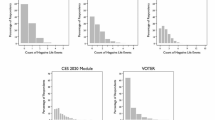Abstract
This analysis of the decline in aggregate voting turnout in the United States between the 1950s and the 1980s attributes the decline to changes in the generational composition of the electorate. In particular, the post-New Deal generation (first presidential vote in 1968 or later), which continues to grow in size, votes at a rate well below that of older generations. A minor part of the generational differences in turnout can be attributed to generational differences in party identification and social connectedness (as measured by such indicators as home ownership and church attendance). The larger portion of generational turnout differences cannot be directly explained with variables contained in the National Election Studies. The generational differences in turnout arenot reflected in preelection participation (informal campaigning, doing party work, etc.) and they cannot be accounted for by a declining sense of political efficacy or citizen duty or by lessened interest in campaigns and election outcomes.
Similar content being viewed by others
References
Abramson, Paul R. (1989). Generations and political change in the United States.Research in Political Sociology 4:235–280.
Abramson, Paul R., and John H. Aldrich (1982). The decline of electoral participation in America.American Political Science Review 76:502–521.
Abramson, Paul R., John H. Aldrich, and David W. Rhode (1982).Change and Continuity in the 1980 Election. Washington, DC: Congressional Quarterly Press.
Barnes, Samuel H., and Max Kaase (1979).Political Action. Beverly Hills: Sage Publications, Inc.
Black, Earle and Merle Black (1987).Politics and Society in the South. Cambridge, MA: Harvard University Press.
Brody, Richard A. (1978). The puzzle of political participation in America. In Anthony King (ed.),The New American Political System. Washington, DC: American Enterprise Institute, p. 290.
Butler, David, and Donald Stokes (1969).Political Change in Britain. London: Macmillan, p. 59.
Carlsson, Gosta, and Katarina Karlsson (1970). Age, cohorts and the generation of generations.American Sociological Review 35:710–718.
Cassell, Carol A. (1987). The origins of Democratic citizen attitudes. Presented at the annual meeting of the American Political Science Association, Chicago.
Cassell, Carol A., and Robert C. Luskin (1988). Simple explanations of turnout decline.American Political Science Review 82:1321–1330.
Converse, Philip E. (1976).The Dynamics of Party Support. Beverly Hills: Sage Publications.
Ferejohn, John A., and James H. Kuklinski (1990).Information and Democratic Processes. Urbana and Chicago: University of Illinois Press.
Inglehart, Ronald (1977)The Silent Revolution. Princeton: Princeton University Press.
Inglehart, Ronald (1990).Culture Shift in Advanced Industrial Society. Princeton: Princeton University Press.
Jennings, M. Kent, and Gregory B. Markus (1984). Partisan orientations over the long haul: Results from the three-wave political socialization panel study.American Political Science Review 78:1000–1018.
Jennings, M. Kent, and Richard G. Niemi (1980).Generations and Politics. Princeton: Princeton University Press.
Jennings, M. Kent, and Jan W. van Deth, et al. (1990).Continuities in Political Action. Berlin and New York: De Gruyter.
Kenney, Patrick J. (1991). A dynamic simultaneous equation model of turnout, forthcoming.
Knack, Stephen (1991) Taking the politics out of voting: Electoral participation as social cooperation. Presented at the annual meeting of the Southwestern Political Science Association, San Antonio.
Kleppner, Paul R. (1982).Who Voted? The Dynamics of Electoral Turnout, 1870–1980. New York: Praeger.
Leighley, Jan (1991). Participation as a stimulus of political conceptualization.Journal of Politics 53:198–212.
Luskin, Robert C. (1987). Explaining political sophistication. Presented at the annual meeting of the Midwest Political Science Association, Chicago.
Mannheim, Karl (1952). The problem of generations. In Paul Kesckemeti (ed.),Essays on the Sociology of Knowledge. London: Routledge and Kegan Paul.
Miller, Warren E. (1980). Disinterest, disaffection, and participation in presidential politics.Political Behavior 2:7–32.
Miller, Warren E. (1990). The electorate's view of the parties. In L. Sandy Maisel (ed.),The Parties Respond. Boulder: Westview Press.
Miller, Warren E. (1991). The stability of party identification, realignment and party voting: Back to the basics.American Political Science Review 85:557–568.
Miller, Warren E., and Teresa Levitin (1976).Leadership and Change: Presidential Elections from 1952–1976. Cambridge, MA: Winthrop Publishers.
Miller, Warren E., and J. Merrill Shanks (1982). Policy directions and presidential leadership: Alternative interpretations of the 1980 presidential election.British Journal of Political Science 12:308.
Pomper, Gerald M., and Loretta Sernekos (1989). The “bake sale” theory of voting participation. Prepared for the annual meeting of the American Political Science Association, Atlanta.
Shaffer, Stephen D. (1981). A multi-variate explanation of decreasing turnout in presidential elections, 1960–1976.American Journal of Political Science 25:68–95.
Stone, Walter, and Ronald Rapoport (1992) Disaggregating political change: The case of the Iowa caucuses, 1984–1988. forthcoming.
Teixeira, Ruy A (1987).Why Americans Don't Vote: Turnout Decline in the United States, 1960–1984. New York: Greenwood Press.
Wolfinger, Raymond E., and Stephen J. Rosenstone (1980).Who Votes? New Haven: Yale University Press.
Author information
Authors and Affiliations
Rights and permissions
About this article
Cite this article
Miller, W.E. The puzzle transformed: Explaining declining turnout. Polit Behav 14, 1–43 (1992). https://doi.org/10.1007/BF00993507
Issue Date:
DOI: https://doi.org/10.1007/BF00993507




